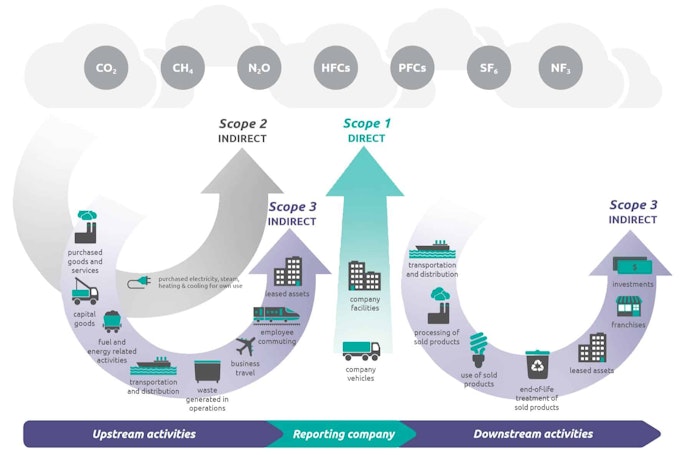Distinguishing the three scopes of greenhouse gas emissions, and what to do about them
Introduction
In the context of fighting climate change, there arises the need for accountability and responsibility of the companies with regards to the effects of their day-to-day activities. In 2015, 196 countries committed to limiting global rise in temperatures through signing the Paris Agreement. Most recent research shows that the urgency has increased even more: the 2021 IPCC (Intergovernmental Panel on Climate Change) report stresses that it is unequivocal that human activity is the cause of the rise in global temperatures.
According to the newly released (2021) IPCC report, since 2011, concentrations of Greenhouse Gas (GHG) emissions in the atmosphere have increased, reaching annual averages much higher than expected. The total range of human induced temperatures has grown from 1850-1900 to 2010-2019 from 0.8 Celsius to 1.3 Celsius.
Types of emissions
Nowadays, measuring and reporting emissions derived from any business has become even more necessary when addressing climate change, since one cannot change what doesn't get measured. The GHG protocol provides an exhaustive methodology and standardized frameworks to measure Greenhouse Gas emissions from private and public sector operations, value chains.In order to identify the different sources of emissions, the GHG framework classifies emissions in three scopes: Scope 1, Scope 2 and Scope 3.
- Scope 1: Direct GHG emissions. This scope accounts for the emissions generated from owned or controlled sources, for example, combustion derived from manufacturing processes, production of electricity by burning coal, burning diesel from transportation, chemical processes…
- Scope 2: Accounts for the indirect emissions from the use of electricity and heat of a given company, including heating and cooling..
- Scope 3: Covers all the other indirect emissions not included in Scope 2 and that take place along a company's value chain, coming from sources outside the direct control of the company. This includes emissions from both the upstream part of the value chain (suppliers making parts of the company’s products), as well as downstream part (customers using the products). Scope 3 emissions often represent the lion's share of the total emissions of a company. They are the more complicated ones to account for and reduce, given their varied origins related to both the supply chain of a company and the use of its products.

Why is it important to measure your carbon footprint across all three scopes?
“What gets measured gets managed”
If we take the example of a company that manufactures cosmetics, and more specifically, if we focused on shampoo production, its direct emissions (Scope 1) would come from its factory where the goods are produced as well as the buildings where different employees work. Scope 2 emissions in this case, would be those that are generated to maintain the facilities, i.e. the air conditioning used in the office buildings. Scope 3 emissions would then include all the emissions generated throughout the supply chain of the shampoo from end to end including its final use. In the case of the shampoo it would include even the hot water consumption used when the final users need to wash their hair. These indirect emissions would typically be 10 times bigger than the Scope 1 and Scope 2 emissions.
These proportions in terms of the different emission scopes are repeated in most of the different industries, which is why when designing a net zero strategy, the scope 3 emissions cannot be left aside. Nowadays, in many cases Scope 3 emissions remain unaccounted for, let alone compensated, maybe because of the complexity of measuring them but most likely because of the negative impact it would have in their profit and losses account, and even on their survival. Transparency plays, thus, a very important role when dealing with a robust net zero strategy.
The path to Net Zero Emissions
In order to pursue a net zero strategy more and more businesses are looking beyond their direct carbon footprint (scope 1 emissions and Scope 2 related to the use of energy) to also include Scope 3 emissions which relate to both their supply chain and the use of their products.
Once a business has identified and targeted the emissions it generates from different sources across all three scopes, targets can be set and different solutions and actions need to be taken to achieve them. This is particularly relevant due to the fact that identifying and tackling the different types of emissions allows businesses to have the information needed in order to set ambitious yet realistic and feasible goals. Setting ambitious goals and monitoring progress helps ensure actions have meaningful impact and results.
It is Reforestum´s mission to help businesses achieve their environmental goals by investing in nature-based initiatives; from planning and implementation, to maintenance and monitoring via our platform.
Reforestum advocates for emissions reductions as the first step that businesses must take in order to pursue a sustainable and net zero strategy. Further down the line, in the process of defining a company's sustainability strategy, it is necessary to offset emissions derived from the business activities. Offsetting businesses' carbon footprint should be an element present in the sustainability strategy of any company, specially when taking into consideration Scope 3 emissions. Natural based offsets such as tree planting also play an important role in sequestering the carbon that has already been released in the atmosphere, closing the carbon cycle and helping mitigate global warming. Furthermore,as long as our society remains fossil fuel´s dependent, the only effective measure for achieving carbon neutrality are carbon offsets.
How Reforestum can help your business to be carbon neutral
Implementing solutions that address all three scopes in a holistic way is thus of great importance. Moreover, transparency is also a key element when tackling the three scopes. Reforestum's solution allows companies to have greater transparency when implementing measures such as offsetting, being accountable for the implementation of and evolution of the solutions as well as allowing for monitoring.
In order to tackle a carbon neutral strategy, it is also important to account for emissions reduction as well as emissions offset. By supporting companies to boost reforestation and forest conservation, and incentivizing them to easily offset their carbon footprint by acquiring and tracking forest shares and carbon credits, great progress can take place. In this sense, and with this purpose it is important to engage all the multiple stakeholders that participate along the different processes of a business, encouraging others, sharing good practices, boosting synergies, as well as joining efforts with customers and suppliers to maximize the impact of the actions taken. Reforestum can help businesses take its first steps towards a net zero implementation and support them in its long-term strategy, as well as supporting them in communicating their story.
It is time to take action! All players are important and can contribute to mitigating the effects of climate change. Businesses that are responsible with the environment and well managed can be the engine for positive change in the world by taking actions such as offsetting their carbon footprint and enabling the right scenario for scaling efforts in a global way.





